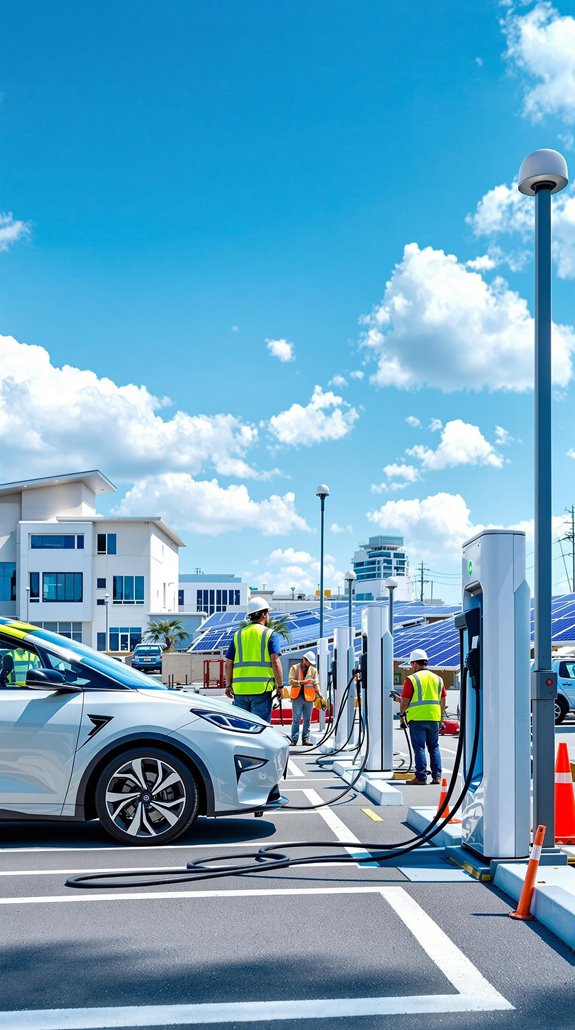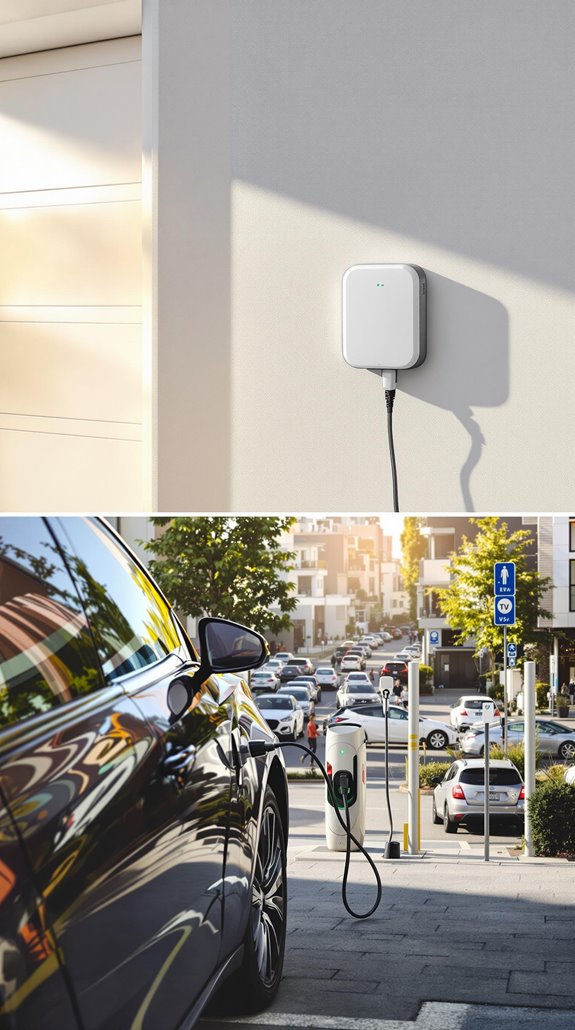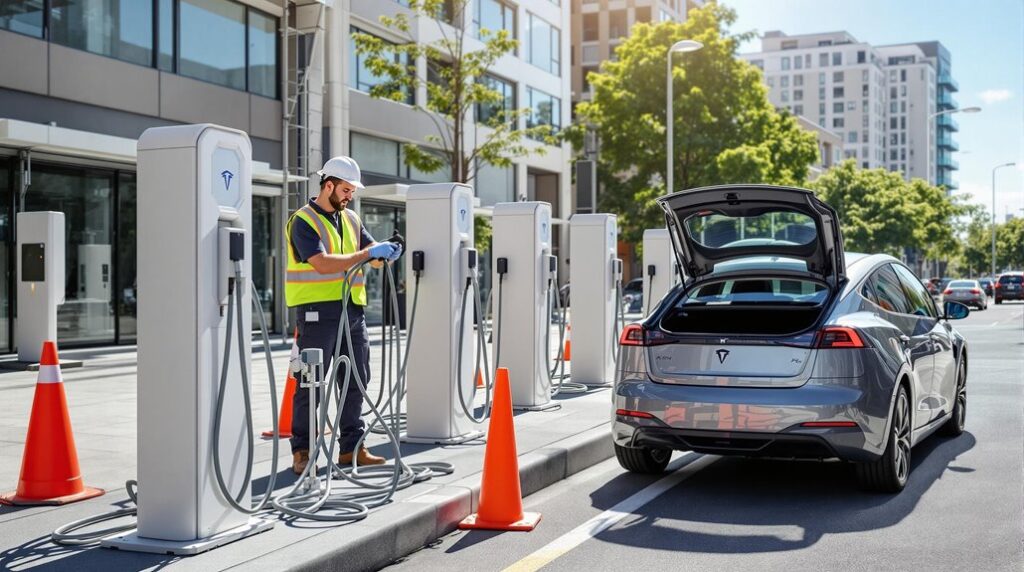I’ve helped dozens of homeowners navigate the electric vehicle charging installation process, and I’ll tell you this: the upfront costs might seem intimidating, but the long-term savings are substantial. You’re looking at an initial investment between $551 and $1,384, yet most people save nearly $950 annually on fuel alone. What catches most homeowners off guard isn’t the installation expense—it’s the hidden factors that can double or triple your final bill if you’re not prepared.
Key Takeaways
- Home EV charging station installation costs average $965 nationally, with Level 2 chargers ranging $500-$700 plus $400-$1,200 labor.
- Federal tax credits offer 30% savings up to $1,000 on equipment and installation costs for residential charging stations.
- Home charging saves approximately $950 annually compared to gasoline vehicles, totaling $3,375-$5,475 over five years.
- Commercial charging infrastructure requires $30,000-$100,000+ investment per point including hardware, installation, and electrical upgrades.
- Environmental benefits include reduced carbon footprint and fossil fuel dependency while providing convenient overnight charging at home.
Understanding Home Charging Station Installation Expenses
When planning your home EV charging station project, you’ll need to budget for several expense categories that go beyond the charger’s sticker price. The national average installation cost runs $965, though you might pay anywhere from $551 to $1,384 depending on your specific setup.
Your biggest expenses will include the charging equipment itself and professional installation labor. Level 1 chargers cost $300-$600 plus installation, while Level 2 units run $500-$700 with similar labor costs of $400-$1,200. Don’t forget potential electrical upgrades—panel improvements can add $600-$1,200 to your total.
However, you can offset these costs through available incentives. Government grants and automaker rebates often reduce your out-of-pocket expenses considerably, making home charging more affordable than initially expected. Some chargers qualify for a 30% Federal tax credit, up to $1,000 for equipment and installation.
Key Factors That Impact Your Charging Setup Costs
Several critical factors will determine your final charging station investment, and understanding each one helps you budget accurately and avoid costly surprises.
Your equipment choice greatly impacts costs. I’ll tell you that Level 2 chargers range from $300 to $50,000, while DC fast chargers cost considerably more. Networked stations add monthly fees but enable revenue generation, whereas non-networked options eliminate ongoing software costs.
Installation complexity drives major expense variations. You’ll face $2,000 to $10,000 in labor costs depending on your site’s electrical distance, terrain, and required trenching work. Electrical panel upgrades increase these figures substantially. Most jurisdictions require permits and compliance with fees ranging from $500 to $5,000.
Smart planning reduces expenses. I recommend bundling multiple installations, utilizing existing infrastructure, and leveraging federal tax credits covering 30% of costs. State rebates and utility partnerships further offset your investment, making strategic timing essential.
Smart Strategies to Reduce Installation Expenses
Since installation costs can quickly spiral beyond your initial budget, implementing targeted cost-reduction strategies becomes essential for maximizing your charging infrastructure investment.
I’ll share five proven approaches that’ll help you cut expenses considerably. First, choose locations near existing electrical infrastructure to minimize upgrade costs. Second, leverage federal, state, and utility funding programs—there’s substantial money available if you know where to look. Third, streamline your permitting process by working with knowledgeable contractors who understand local requirements.
Fourth, optimize your technical setup by scheduling charging during off-peak hours and considering Level II chargers for lower upfront costs. Additionally, assess your usage patterns carefully since slower chargers may be adequate if most charging occurs overnight or during work hours. Finally, plan for future expansion by installing necessary wiring during initial construction—it’s much cheaper than retrofitting later.
Advantages of Home Electric Vehicle Charging
While public charging networks continue expanding, home charging delivers unmatched advantages that’ll transform your electric vehicle ownership experience. You’ll eliminate detours to locate charging stations and wake up to a full battery every morning. I’ve found that integrating charging into your daily routine removes range anxiety completely.
Your wallet will thank you too. Home charging costs about $60 monthly for average usage, delivering $6,000–$12,000 in long-term savings over gasoline vehicles. You’ll access off-peak electricity rates and available rebates that offset installation costs.
You’ll gain complete control through customizable charging schedules while avoiding public station queues. Public charging typically costs 3-5 times higher than home charging rates. Plus, you’re reducing your carbon footprint and increasing your home’s value. Smart homeowners recognize that installing home charging future-proofs their property for widespread EV adoption.
Commercial Public Charging Infrastructure Investment Requirements

Commercial public charging infrastructure demands substantial upfront investment that extends far beyond simple equipment purchases. I’ll walk you through the real costs you’re facing.
Your hardware investment ranges from $300 for basic Level 1 units to $40,000 for DC fast chargers. Installation adds another layer: Level 2 stations cost $600–$12,000 to install, while DC fast chargers require $30,000–$50,000+ for complex grid integration.
You’ll need electrical infrastructure upgrades costing $10,000–$50,000+ for high-power installations. Don’t overlook ongoing expenses: $50–$200 monthly network fees per charger, electricity costs, and maintenance.
Your total investment per charging point can reach $100,000 when combining hardware, installation, and infrastructure upgrades. Financial incentives from federal, state, and local governments can significantly reduce these initial costs. Plan for 5–10 year ROI calculations.
Operational Challenges Facing Public Charging Networks
Beyond your initial investment, you’ll face ongoing operational challenges that can make or break your charging network’s success. Connectivity issues plague 55% of failed sessions, directly cutting your revenue and damaging your reputation. You’ll deal with hardware malfunctions affecting 76% of charger problems—broken screens, unresponsive interfaces, and weather damage requiring constant repairs. Payment system failures disrupt 23% of sessions, with complex billing interfaces frustrating your customers. Expect maintenance costs averaging 15-30% of installation expenses, plus unplanned electrical grid upgrades. Grid capacity limitations will block high-speed charger deployment at 30% of viable locations. Vehicle compatibility issues across fragmented charging standards (CCS, CHAdeMO, NACS) complicate universal access, while peak-time congestion reduces urban availability by 40%. Your charging infrastructure becomes a vulnerable target for cyberattacks due to its connection to critical infrastructure, exposing both your network operations and customer data to potential security breaches.
Comparing Home Vs Public Charging Economics

When you’re deciding between home and public charging for your electric vehicle, the economics tell a clear story: home charging delivers substantially lower costs but requires significant upfront investment.
You’ll spend $1,000-$4,500 initially for home charging equipment and installation, but federal incentives can offset 30-50% of these costs. Your ongoing savings are substantial—home electricity averages $0.17/kWh versus public charging’s $0.32-$0.48/kWh.
I’ll show you the math: charging 14,000 miles annually costs $1,425 at home versus $2,100-$2,520 publicly in California. Over five years, you’ll save $3,375-$5,475 with home charging.
You’ll also avoid membership fees, idle charges, and queue times while accessing overnight utility rates. EV drivers who optimize their charging strategy can achieve annual fuel savings of approximately $950 compared to traditional gasoline vehicles. Plus, your home charging station increases property value by 1.5-3%.
Conclusion
I’ve walked you through the essential steps for evaluating EV charging installation costs and benefits. You’ll save nearly $950 annually while adding 1.5-3% to your property value. Start by evaluating your electrical capacity, get multiple contractor quotes, and explore available rebates. Calculate your specific savings using your driving habits and local electricity rates. With proper planning, you’ll maximize both financial returns and charging convenience while supporting sustainable transportation.
References
- https://www.angi.com/articles/installing-electric-car-charging-station.htm
- https://mccarthyelectricandtechnologies.com/blog/top-5-benefits-of-installing-a-home-ev-charging-station/
- https://www.homeadvisor.com/cost/garages/install-an-electric-vehicle-charging-station/
- https://xovacharging.com/blog/the-pros-and-cons-of-installing-a-public-ev-charging-station/
- https://www.sparkcharge.io/post/ev-charging-station-infrastructure-costs
- https://pulseenergy.io/blog/home-ev-charging-point
- https://qmerit.com/faq/how-much-does-installation-cost/
- https://www.wmhendersoninc.com/blog/benefits-of-installing-an-electric-car-charging-station-at-home/
- https://www.capitalone.com/cars/learn/managing-your-money-wisely/how-much-does-a-home-ev-charger-really-cost/2737
- https://cyberswitching.com/how-much-does-it-cost-add-ev-charging-stations-my-businesss-parking-lot/

